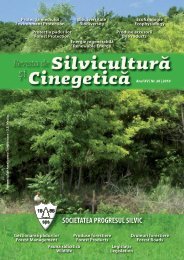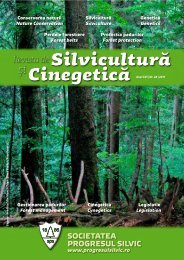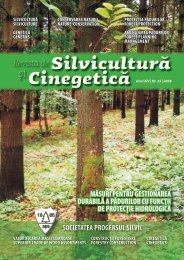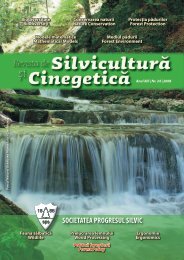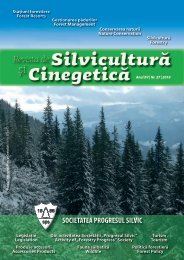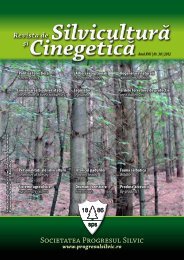Silviculture and Cinegetics Review - Societatea Progresul Silvic
Silviculture and Cinegetics Review - Societatea Progresul Silvic
Silviculture and Cinegetics Review - Societatea Progresul Silvic
Create successful ePaper yourself
Turn your PDF publications into a flip-book with our unique Google optimized e-Paper software.
FORESTRY BELTS SILVICULTURE AND CINEGETICS REVIEW XVII/30/2012<br />
Technical solutions to set up networks of forest shelterbelts for farml<strong>and</strong><br />
protection in the Plain <strong>and</strong> the Dobrogea Plateau<br />
Cornel Costăchescu, Florin Dănescu, Marian Ianculescu, Elena Mihăilă, Dan Niţu<br />
1. Introduction<br />
As signatory of “Convention for Desertification<br />
Combat” from 1994, Romania should contribute to<br />
achieving its main objective of “combating<br />
desertification <strong>and</strong> mitigating the effects of drought in<br />
countries with serious problems of drought <strong>and</strong>/or<br />
desertification through efficient actions at all levels, in<br />
order to contribute to achieving sustainable<br />
development in the affected areas”.<br />
Romania is part of the 110 countries around the globe<br />
where there are potential affected areas by<br />
desertification, as a result of frequent long-lasting <strong>and</strong><br />
severe droughtness periods, mainly due to the<br />
imbalanced climatic characteristics, as well as severe<br />
reduction of the area covered with forest vegetation in<br />
the plains <strong>and</strong> low hilly regions.<br />
It is estimated that desertification, droughtness <strong>and</strong><br />
aridity have a temporary <strong>and</strong> spatial determination,<br />
being mainly caused by the climatic variations <strong>and</strong><br />
human activity. As a result, desertification or longlasting<br />
severe droughtness are accompanied by l<strong>and</strong>,<br />
soil, vegetation <strong>and</strong> hydrological resources<br />
degradation processes, even in the dry sub-humid<br />
areas.<br />
The forest crops <strong>and</strong> the forest shelterbelts, as<br />
defensive methods against climatic specific<br />
adversities, as soil protection methods against erosion<br />
<strong>and</strong> l<strong>and</strong>slides, as protection methods of socioeconomical<br />
objectives <strong>and</strong> communication ways were<br />
<strong>and</strong> are presently monitored by all agricultural<br />
developed countries where the crops, the soil <strong>and</strong> the<br />
dwellings suffer more or less of the harmful winds<br />
influence, droughtness <strong>and</strong> surface erosion<br />
(Ianculescu, 2005, 2007, 2008).<br />
Forest shelterbelts are forest vegetation structures, of<br />
different lengths <strong>and</strong> relatively narrow widths, located<br />
at a certain distance from each other or against a<br />
certain objective, aiming to protect against the effects<br />
of harmful factors, whose effects are manifested more<br />
intensely in terms of their integration into a much<br />
extended network.<br />
Are generally known the beneficial influences of those<br />
forest shelterbelts on crops <strong>and</strong> agricultural <strong>and</strong><br />
zootechny production, on soil <strong>and</strong> water, useful fauna,<br />
people’s health <strong>and</strong> human settlements, in brief on<br />
environment in the areas where they are installed.<br />
In summary, the main ecological, social <strong>and</strong><br />
economical effects of forest shelterbelts establishment<br />
consist of (Lupe, 1952, 1953; Popescu, 1954;<br />
Costăchescu et al., 2005):<br />
- improving the microclimatic conditions modifying<br />
the albedo, decreasing the air diurnal amplitude<br />
temperature by 1-4 0C <strong>and</strong> the annual one by 1-2 0C,<br />
decreasing the wind speed by 31-55% in the sheltered<br />
side <strong>and</strong> by 10-15% in the exposed side, reducing the<br />
unproductive evapo-transpiration by up to 30%,<br />
increasing the air humidity at the soil surface by 3-<br />
5%;<br />
- improving growth <strong>and</strong> development conditions of<br />
agricultural adjacent crops to a distance of 20-30<br />
times of the shelterbelt height at the leeward<br />
(sheltered) <strong>and</strong> by 5-12 times of the shelterbelt height<br />
in the wind one (exposed);<br />
- improving the fertility conditions <strong>and</strong> the soil<br />
conservation, reducing erosion <strong>and</strong> slopes runoff up to<br />
total stopping, increasing soil moisture, enriching the<br />
soil content in humus <strong>and</strong> other nutrients, <strong>and</strong><br />
modifying the soil pH due to the organic matter<br />
excess produced by leaves <strong>and</strong> roots;<br />
-increasing the wood biomass <strong>and</strong> accessory products;<br />
- increasing the areas covered with forest vegetation;<br />
-protecting socio-economical objectives <strong>and</strong><br />
communication ways;<br />
-creating favourable conditions for the local fauna<br />
development;<br />
- increasing the regional biodiversity;<br />
- improving carbon stock;<br />
- reconstruction <strong>and</strong> improvement of the l<strong>and</strong>scape.<br />
Therefore, the achievement of the forest shelterbelts<br />
networks has consequences not only for protecting<br />
<strong>and</strong> preserving environmental conditions, but also for<br />
increasing agricultural productions, or at least,<br />
maintaining them at a relatively constant level even<br />
under significant fluctuating climatic conditions.<br />
The necessity of forest shelterbelts has been revealed<br />
since 1860 by Ion Ionescu de la Brad, who achieved<br />
the first “wind overshadowing plantations” during<br />
1870-1872.



